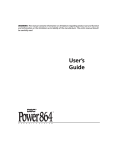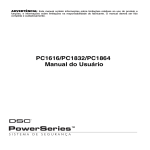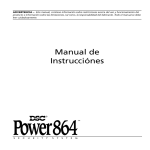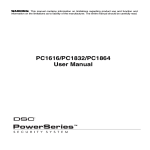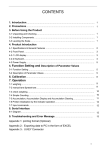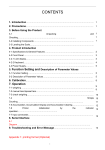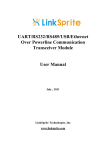Download DSC864
Transcript
WARNING: This manual contains information on limitations regarding product use and function and information on the limitations as to liability of the manufacturer. The entire manual should be carefully read. User’s Guide Quick R ef er e n ce Gu i d e The following chart lists the basic functions of your system alphabetically, and the keys to press for each function. Refer to the listed page number for more information. NOTE: Some functions may not be available on your system. Ask your installer for more information. To do this: Press this: See page: Arm system (Away): ................................ [access code], leave through entry/exit door OR press (if enabled) 8 Arm system (No Entry Delay): .................. [access code] 10 Arm system (Quick, if enabled): ............... (from Ready state) 10 Arm system (Stay):................................... [access code], do not exit premises OR press (if enabled) Bypass zones: .......................................... [two-digit zone number(s)], 9 to exit Disarm system: ........................................ [access code] Exit premises when system armed: .......... OR press 16 12 (if enabled) Reset smoke detectors............................. OR press (if enabled) Send Fire message: .................................. (press & hold for 2 seconds, if enabled) 12 13 15 Send Auxiliary message: .......................... (press & hold for 2 seconds, if enabled) 15 Send Panic message: ............................... (press & hold for 2 seconds, if enabled) 15 Set time and date:................................... [master code] 23 Silence fire alarm: .................................... [access code] 13 Silence intrusion alarm: ........................... [access code] 14 Test system.............................................. 20 Turn door chime on/off:............................. Turn on bypassed zones (if Stay armed): .. [master code] to toggle on or off OR press (if enabled) OR press (if enabled) View alarm memory: ............................... View event buffer.................................... View troubles .......................................... 21 9 14 [master code], scroll to View Event Buffer 19 18 Tabl e o f C o n t en t s Keypad Buttons & Lights About This Guide 1 Introduction 2 4 5 How Your System Works .......................................................................................................5 IMPORTANT NOTICE ..............................................................................................................5 Fire Detection ........................................................................................................................6 Testing ..................................................................................................................................6 Remote Monitoring ...............................................................................................................6 Maintenance .........................................................................................................................6 2 Arming and Disarming Your System 7 Getting Ready to Arm Your System .......................................................................................7 Arming Your System ..............................................................................................................8 Away Arming ........................................................................................................................8 Bell/Siren Sounds After Away Arming ....................................................................................9 Stay Arming ..........................................................................................................................9 Quick Arm ...........................................................................................................................10 “No Entry” Arming ..............................................................................................................10 Automatic Arming ...............................................................................................................11 Quick Exit ............................................................................................................................12 Disarming Your Security System ...........................................................................................12 3 Dealing With Alarms and Emergencies 13 Fire Alarms ..........................................................................................................................13 Intrusion (Burglary) Alarms ...................................................................................................14 Viewing Alarms in Memory ..................................................................................................14 Calling for Help ...................................................................................................................15 4 Using Advanced Functions 16 Bypassing Zones ..................................................................................................................16 Recalling Bypassed Zones .....................................................................................................17 Bypass Groups .....................................................................................................................17 Identifying Trouble Conditions .............................................................................................18 Viewing the Event Buffer from an LCD5500Z Keypad ..........................................................19 Testing Your System ............................................................................................................20 Allowing Computer Access to Your System .........................................................................21 Turning the Door Chime On or Off ......................................................................................21 5 Customizing Your System 22 Programming Access Codes .................................................................................................22 Setting the Time and Date ...................................................................................................23 Changing the LCD5500Z Display Language .........................................................................23 Changing LCD5500Z Display Brightness/Contrast ................................................................23 Changing Keypad Sounder Loudness ...................................................................................24 6 Fire Safety 25 Household Fire Safety Audit .................................................................................................25 Fire Escape Planning ............................................................................................................25 7 Glossary 8 System Information Index 27 29 31 1 2 U s i n g A d v an c e d F u n c t i o n s : A l l o w i n g C o m p u t e r A c c e s s t o Y o u r S ys te m Allowing Computer Access to Your System From time to time, your installer may need to send information to or retrieve information from your security system. Your installer will do this by having a computer call your system over the telephone line. You may need to prepare your system to receive this “downloading” call. To do this: 1. Press [Master code] at any keypad. This allows downloading for a limited period of time. During this time, the system will answer incoming downloading calls. For more information on this feature, please ask your installer. Turning the Door Chime On or Off If your installer has enabled the door chime feature, your system keypads will sound a tone, or beeps whenever designated doors or windows are opened or closed. Your installer has programmed which doors and windows will activate the door chime. 1. Press to turn the door chime feature ON The keypad will beep 3 times. 2. Press again to turn the door chime feature OFF The keypad will sound one long beep. 21 Section 5: Customizing Your System This section describes how to customize your system to your needs. Refer to this section for detailed instructions on: programming access codes, setting the time and date, and adjusting the keypad sounders and lights. Programming Access Codes The master code (code 40) can be used to program system options, arm and disarm the system and program other access codes. You can program up to 32 additional access codes (01 through 32). You can change or program access codes at both PC55XXZ and LCD keypads. Other access codes, such as system supervisory and duress codes, are available. Contact your installer for more information. LCD5500Z Keypads 1. Press 2. Use the 3. Press to enter the function list. keys to scroll to “Press (*) for <> Access Codes”. . The keypad will display “(*) to Edit User Code 01P”. 4. Scroll to the code you want to program using the keys. If there is a letter “P” beside the code number (e.g. [01P]), that code has already been programmed. If there is no “P”, then no code is programmed for that access code number. If an access code already exists for the code number you select, it will be replaced by the new code. 5. To select a code for editing, press Code < >”. . The keypad will display “Enter New 6. Enter the new [code]. All codes must be four digits unless otherwise indicated by your installer. Enter digits 0 through 9 only. Once the code has been entered, the keypad will beep 3 times. NOTE: Do not use the factory default or obvious codes such as [1111] or [1234]. The keypad will display “(*) to Edit User Code 01P”. 7. To exit access code programming, press . 8. Record your new codes on the “System Information” page in this booklet. PC55XXZ and LCD5501Z Keypads 1. Press [Master Code]. The Program indicator flashes. 2. Enter the two-digit number of the access code you want to program (01-32 for access codes, 40 for master code). If an access code already exists for the code number you have selected, it will be replaced by the new code. 3. Enter the new [code]. Access codes must be four digits unless otherwise indicated by your installer. Enter digits 0 through 9 only. NOTE: Do not use the factory default or obvious codes such as [1111] or [1234]. 4. To exit access code programming, press . 5. Record your new codes on the “System Information” page in this booklet. 22 C u s t o m i z i n g Y o u r S ys te m : S e tt i n g t h e T i m e a n d D a te Erasing a code: 1. Press [Master Code] 2. Enter the number of the code you want to erase [01 to 32]. The Master code cannot be erased. 3. To erase the code, press . 4. To exit access code programming, press Setting the Time and Date . You should make sure that your system has the correct time and date. This is important for the auto-arm feature to function correctly, and for accurate reporting of events. 1. Press [Master Code] . 2. The keypad will now accept 10 consecutive digits: • Enter the Time in Hours and Minutes using the 24-Hour format (00:00 to 23:59). • Enter the Date in Months, Days and Years (MM DD YY). 4. To exit programming, press . NOTE: If you have an LCD keypad, your installer may have programmed your system to display the time and date while the keypad is idle. If this is the case, you can press the key to clear the date and time display. Changing the LCD5500Z Display Language You can change the language displayed on the LCD5500Z keypad. 1. Press and hold both of the keys together. 2. The keypad will enter Language Selection mode. Scroll to the language you want the keypad to display. 3. To select a language and restart the keypad, press Changing LCD5500Z Display Brightness/ Contrast . You can change the brightness and contrast of the LCD display on LCD5500Z keypads. 1. Press [Master code]. 2. Use the 3. Press keys to scroll to either Brightness Control or Contrast Control. to select the setting you want to adjust. 4. A) “Brightness Control”: There are10 different backlighting levels. Use the keys to scroll to the desired level. B) “Contrast Control”: There are 10 different display contrast levels. Use the keys to scroll to the desired contrast level. 5. To exit, press . 23 Changing Keypad Sounder Loudness You can select from 21 different keypad sounder tones for LCD and PC55XXZ keypads From an LCD5500Z keypad: 1. Press [Master Code]. 2. Use the trol”. 3. Press keys to scroll to the message “Select Option <> Buzzer Conto select. 4. Use the keys to scroll to the desired keypad sound level. 5. To exit, press . From a PC55XXZ or LCD5501Z keypad: Press and hold the 24 key until the desired keypad sounder level is reached. Section 6: Fire Safety Read this section carefully for important information about fire safety. Household Fire Safety Audit Most fires occur in the home. To minimize this danger, we recommend that a household fire safety audit is conducted and a fire escape plan is developed. 1. Are all electrical appliances and outlets in a safe condition? Check for frayed cords, overloaded lighting circuits, etc. If you are uncertain about the condition of your electrical appliances or household service, have a professional evaluate these units. 2. Are all flammable liquids stored safely in closed containers in a well-ventilated cool area? Cleaning with flammable liquids should be avoided. 3. Are fire hazardous materials (matches) well out of reach of children? 4. Are furnaces and wood burning appliances properly installed, clean and in good working order? Have a professional evaluate these appliances. Fire Escape Planning There is often very little time between the detection of a fire and the time it becomes deadly. It is thus very important that a family escape plan be developed and rehearsed. 1. Every family member should participate in developing the escape plan. 2. Study the possible escape routes from each location within the house. Since many fires occur at night, special attention should be given to the escape routes from sleeping quarters. 3. Escape from a bedroom must be possible without opening the interior door. Consider the following when making your escape plans: • Make sure that all border doors and windows are easily opened. Ensure that they are not painted shut, and that their locking mechanisms operate smoothly. • If opening or using the exit is too difficult for children, the elderly or handicapped, plans for rescue should be developed. This includes making sure that those who are to perform the rescue can promptly hear the fire warning signal. • If the exit is above the ground level, an approved fire ladder or rope should be provided as well as training in its use. • Exits on the ground level should be kept clear. Be sure to remove snow from exterior patio doors in winter; outdoor furniture or equipment should not block exits. • Each person should know of a predetermined assembly point where everyone can be accounted for i.e.: across the street or at a neighbor’s house. Once everyone is out of the building, call the Fire Department. 25 • A good plan emphasizes quick escape. Do not investigate or attempt to fight the fire, and do not gather belongings or pets as this wastes valuable time. Once outside, do not re-enter the house. Wait for the fire department. • Write the fire escape plan down and rehearse it frequently so that should an emergency arise, everyone will know what to do. Revise the plan as conditions change, such as the number of people in the home, or if there are changes to the building’s construction. • Make sure your fire warning system is operational by conducting weekly tests (see “Testing Your System” on page 20). If you are unsure about system operation, contact your installing dealer. • We recommend that you contact your local fire department and request further information on fire safety and escape planning. If available, have your local fire prevention officer conduct an in-house fire safety inspection. 26 Section 7: Glossary Access code A 4- or 6-digit code that allows access to arming, disarming and other system functions. Alarm When a zone is violated (e.g. a smoke detector detects smoke, a motion detector senses movement, a door with a contact is opened), it will trigger an alarm. Intrusion (burglary) alarm: An alarm triggered by an intrusion detector (e.g. motion detectors, glassbreak detectors, door/window contacts). Usually occurs when the system is armed. Fire alarm: An alarm triggered by fire, smoke or heat detectors. Fire alarms may be triggered at any time, whether the system is armed or not. Audible exit fault A feature that warns you of an improper exit (e.g. door not completely shut) when you attempt to arm your system. Helps to prevent false alarms. Away arming Arming the system so that all the zones (border and interior) are turned on. (Used when everyone is away from the premises.) Bypassing zones When you bypass a zone, the detector for that zone will no longer monitor activity in the zone and will not be able to trigger an alarm. Central Station If remote monitoring is enabled, your system will send alarms, troubles and emergency messages to the central station. The central station will then notify authorities in your area, if necessary. Detector A part of the system that can detect problems and report them to the control panel (e.g. a motion detector can tell the control panel if there is movement in a zone). Emergency Message A message sent to the central station when one of the pairs of emergency keys ( ) is pressed and held for two seconds. Your installer must program these keys, or they will not work. Entry delay A timer programmed by your installer. It starts when you enter an armed area of the system. You must enter an access code to disarm the system before the timer runs out, or else an alarm will be triggered. 27 Entry/exit doors Your installer will program the doors you usually use to enter or exit the premises as entry/exit doors. These doors will be programmed to have entry and exit delays. Keypads will normally be placed near the entry/exit delay doors for easy access to arming/disarming functions. Event buffer The event buffer contains a list of the last 256 events that have occurred on your system. You must be at an LCD5500Z keypad to view the event buffer. Exit delay A timer programmed by your installer. It starts when you arm your system, to allow you a period of time in which to leave the premises. At the end of the exit delay, the system will be armed. Master code The master code is a 4- or 6- digit access code that is used to program system options, to arm and disarm the system, and to program other access codes. Partition A group of zones that can be turned on or off together. Certain access codes may have access to only some partitions. See Zone. Stay arming Arming the system so that only the border zones are turned on. (Used when one or more people will stay on the premises.) Trouble The control panel continuously checks the system for conditions that may reduce its effectiveness. If the control panel finds one of these conditions (trouble), it will indicate this at the keypad(s) to alert users to the problem. See “Identifying Trouble Conditions” on page 18 for a list of possible trouble conditions. Zone A limited area of the premises monitored by a detector (smoke detector, door/window contact, motion detector, glassbreak detector, etc.). Border zone: A zone that detects intrusion from outside the premises (e.g. door contact on an outside door, glassbreak detector, etc.). Interior zone: A zone that detects intruders that have already entered (e.g. door contact on an interior door between rooms, motion detector, etc.). Fire zone: A zone with a heat or smoke detector. 28 System Information Fill out the following information for future reference and store this guide in a safe place. For Service Central Station Information: Account #:_______________________________ Telephone #: ____________________________ Installer Information: Company: _______________________________ Telephone #: ___________________________ Access Codes Your Master Code is: ____________________________ Additional Access Codes: Code # Access Code Code # Access Code Code # Access Code Code # 01 09 17 25 02 10 18 26 03 11 19 27 04 12 20 28 05 13 21 29 06 14 22 30 07 15 23 31 08 16 24 32 Access Code System Information [F] FIRE _____________________________________ [A] AUXILIARY_______________________________ [P] PANIC ___________________________________ The Exit Delay Time is ________________ seconds. The Entry Delay Time is _______________ seconds. 29 Zone Information There are ________ active zones on the system. Zone 30 Protected Area Zone Type Zone 01 33 02 34 03 35 04 36 05 37 06 38 07 39 08 40 09 41 10 42 11 43 12 44 13 45 14 46 15 47 16 48 17 49 18 50 19 51 20 52 21 53 22 54 23 55 24 56 25 57 26 58 27 59 28 60 29 61 30 62 31 63 32 64 Protected Area Zone Type Index A D L T Access codes adding 22 changing 22 defined 27 erasing 23 Master code 28 programming 22 Alarm defined 27 false 13 fire 13 intrusion 14 memory 14 viewing 14 Arming automatic 11 away 8 getting ready 7 no entry delay 10 quick 10 stay 9 Automatic arming 11 Auxiliary keys 15 Away arming 8 Date clearing display 23 setting 23 Detectors defined 27 Disarming 12 Display brightness 23 contrast 23 description 2 Door chime 21 entry/exit 8, 28 Downloading 21 Language 23 Lights on keypad 2 Testing 6 entire system 20 keypad sounder 20 siren 20 Time clearing display 23 setting 23 Trouble defined 28 messages 18 Turning off system See Disarming Turning on system See Arming B Bells testing 20 Buttons on keypad 2 Bypass group 17 Bypassing zones 16 C Central station 6 defined 27 Cleaning the system 6 Codes See Access codes Computer access to system 21 E Emergency keys 15 Entry delay 12 defined 27 Entry/exit door defined 28 Events viewing 19 Exit quick 12 Exit delay 8 defined 28 F False alarm 13 Fire alarm 13 detection 6 escape planning 25 keys 15 safety 25 Function buttons 2, 8, 10 K Keypad brightness 23 contrast 23 descriptions 2 language 23 sounder 24 M Maintenance of system 6 Master code 28 Monitoring station 6 P Panic keys 15 Partition defined 28 Problem, See Trouble Programming automatic arming 11 codes 22 time and date 23 Q Quick arming 10 exit 12 R Ready light 7 Ready state 7 Remote monitoring 6 V Viewing alarms 14 events 19 troubles 18 Z Zones bypassing 16 defined 28 testing 20 S Secure system 7 Siren testing 20 Stay arming 9 System arming 8 disarming 12 how it works 5 maintenance 6 securing 7 testing 6, 20 trouble 18 31 Limited Warranty Digital Security Controls Ltd. warrants the original purchaser that for a period of twelve months from the date of purchase, the product shall be free of defects in materials and workmanship under normal use. During the warranty period, Digital Security Controls Ltd. shall, at its option, repair or replace any defective product upon return of the product to its factory, at no charge for labour and materials. Any replacement and/or repaired parts are warranted for the remainder of the original warranty or ninety (90) days, whichever is longer. The original owner must promptly notify Digital Security Controls Ltd. in writing that there is defect in material or workmanship, such written notice to be received in all events prior to expiration of the warranty period. In t e r na t i o n al War r a n ty The warranty for international customers is the same as for any customer within Canada and the United States, with the exception that Digital Security Controls Ltd. shall not be responsible for any customs fees, taxes, or VAT that may be due. War r a n ty P r o c e d u r e To obtain service under this warranty, please return the item(s) in question to the point of purchase. All authorized distributors and dealers have a warranty program. Anyone returning goods to Digital Security Controls Ltd. must first obtain an authorization number. Digital Security Controls Ltd. will not accept any shipment whatsoever for which prior authorization has not been obtained. C o n d it i o n s t o Vo i d Wa r r an ty This warranty applies only to defects in parts and workmanship relating to normal use. It does not cover: • damage incurred in shipping or handling; • damage caused by disaster such as fire, flood, wind, earthquake or lightning; • damage due to causes beyond the control of Digital Security Controls Ltd. such as excessive voltage, mechanical shock or water damage; • damage caused by unauthorized attachment, alterations, modifications or foreign objects; • damage caused by peripherals (unless such peripherals were supplied by Digital Security Controls Ltd.); • defects caused by failure to provide a suitable installation environment for the products; • damage caused by use of the products for purposes other than those for which it was designed; • damage from improper maintenance; • damage arising out of any other abuse, mishandling or improper application of the products. Digital Security Controls Ltd.’s liability for failure to repair the product under this warranty after a reasonable number of attempts will be limited to a replacement of the product, as the exclusive remedy for breach of warranty. Under no circumstances shall Digital Security Controls Ltd. be liable for any special, incidental, or consequential damages based upon breach of warranty, breach of contract, negligence, strict liability, or any other legal theory. Such damages include, but are not limited to, loss of profits, loss of the product or any associated equipment, cost of capital, cost of substitute or replacement equipment, facilities or services, down time, purchaser’s time, the claims of third parties, including customers, and injury to property. 32 D i s c l ai m e r o f Wa r r a n t i e s This warranty contains the entire warranty and shall be in lieu of any and all other warranties, whether expressed or implied (including all implied warranties of merchantability or fitness for a particular purpose) And of all other obligations or liabilities on the part of Digital Security Controls Ltd. Digital Security Controls Ltd. neither assumes nor authorizes any other person purporting to act on its behalf to modify or to change this warranty, nor to assume for it any other warranty or liability concerning this product. This disclaimer of warranties and limited warranty are governed by the laws of the province of Ontario, Canada. WARNING: Digital Security Controls Ltd. recommends that the entire system be completely tested on a regular basis. However, despite frequent testing, and due to, but not limited to, criminal tampering or electrical disruption, it is possible for this product to fail to perform as expected. I n st al l e r ’s L o c ko ut Any products returned to DSC which have the Installer’s Lockout option enabled and exhibit no other problems will be subject to a service charge. O u t o f Wa r r an t y R e p a i r s Digital Security Controls Ltd. will at its option repair or replace out-of-warranty products which are returned to its factory according to the following conditions. Anyone returning goods to Digital Security Controls Ltd. must first obtain an authorization number. Digital Security Controls Ltd. will not accept any shipment whatsoever for which prior authorization has not been obtained. Products which Digital Security Controls Ltd. determines to be repairable will be repaired and returned. A set fee which Digital Security Controls Ltd. has predetermined and which may be revised from time to time, will be charged for each unit repaired. Products which Digital Security Controls Ltd. determines not to be repairable will be replaced by the nearest equivalent product available at that time. The current market price of the replacement product will be charged for each replacement unit. WARNING Please Read Carefully N o te t o I n s t a lle r s This warning contains vital information. As the only individual in contact with system users, it is your responsibility to bring each item in this warning to the attention of the users of this system. S ys te m F ai lu re s This system has been carefully designed to be as effective as possible. There are circumstances, however, involving fire, burglary, or other types of emergencies where it may not provide protection. Any alarm system of any type may be compromised deliberately or may fail to operate as expected for a variety of reasons. Some but not all of these reasons may be: ■ Inadequate Installation A security system must be installed properly in order to provide adequate protection. Every installation should be evaluated by a security professional to ensure that all access points and areas are covered. Locks and latches on windows and doors must be secure and operate as intended. Windows, doors, walls, ceilings and other building materials must be of sufficient strength and construction to provide the level of protection expected. A reevaluation must be done during and after any construction activity. An evaluation by the fire and/or police department is highly recommended if this service is available. ■ Criminal Knowledge This system contains security features which were known to be effective at the time of manufacture. It is possible for persons with criminal intent to develop techniques which reduce the effectiveness of these features. It is important that a security system be reviewed periodically to ensure that its features remain effective and that it be updated or replaced if it is found that it does not provide the protection expected. ■ Access by Intruders Intruders may enter through an unprotected access point, circumvent a sensing device, evade detection by moving through an area of insufficient coverage, disconnect a warning device, or interfere with or prevent the proper operation of the system. ■ Power Failure Control units, intrusion detectors, smoke detectors and many other security devices require an adequate power supply for proper operation. If a device operates from batteries, it is possible for the batteries to fail. Even if the batteries have not failed, they must be charged, in good condition and installed correctly. If a device operates only by AC power, any interruption, however brief, will render that device inoperative while it does not have power. Power interruptions of any length are often accompanied by voltage fluctuations which may damage electronic equipment such as a security system. After a power interruption has occurred, immediately conduct a complete system test to ensure that the system operates as intended. ■ Failure of Replaceable Batteries This system’s wireless transmitters have been designed to provide several years of battery life under normal conditions. The expected battery life is a function of the device environment, usage and type. Ambient conditions such as high humidity, high or low temperatures, or large temperature fluctuations may reduce the expected battery life. While each transmitting device has a low battery monitor which identifies when the batteries need to be replaced, this monitor may fail to operate as expected. Regular testing and maintenance will keep the system in good operating condition. ■ Compromise of Radio Frequency (Wireless) Devices Signals may not reach the receiver under all circumstances which could include metal objects placed on or near the radio path or deliberate jamming or other inadvertent radio signal interference. ■ System Users A user may not be able to operate a panic or emergency switch possibly due to permanent or temporary physical disability, inability to reach the device in time, or unfamiliarity with the correct operation. It is important that all system users be trained in the correct operation of the alarm system and that they know how to respond when the system indicates an alarm. ■ Smoke Detectors Smoke detectors that are a part of this system may not properly alert occupants of a fire for a number of reasons, some of which follow. The smoke detectors may have been improperly installed or positioned. Smoke may not be able to reach the smoke detectors, such as when the fire is in a chimney, walls or roofs, or on the other side of closed doors. Smoke detectors may not detect smoke from fires on another level of the residence or building. Every fire is different in the amount of smoke produced and the rate of burning. Smoke detectors cannot sense all types of fires equally well. Smoke detectors may not provide timely warning of fires caused by carelessness or safety hazards such as smoking in bed, violent explosions, escaping gas, improper storage of flammable materials, overloaded electrical circuits, children playing with matches or arson. Even if the smoke detector operates as intended, there may be circumstances when there is insufficient warning to allow all occupants to escape in time to avoid injury or death. ■ Motion Detectors Motion detectors can only detect motion within the designated areas as shown in their respective installation instructions. They cannot discriminate between intruders and intended occupants. Motion detectors do not provide volumetric area protection. They have multiple beams of detection and motion can only be detected in unobstructed areas covered by these beams. They cannot detect motion which occurs behind walls, ceilings, floor, closed doors, glass partitions, glass doors or windows. Any type of tampering whether intentional or unintentional such as masking, painting, or spraying of any material on the lenses, mirrors, windows or any other part of the detection system will impair its proper operation. Passive infrared motion detectors operate by sensing changes in temperature. However their effectiveness can be reduced when the ambient temperature rises near or above body temperature or if there are intentional or unintentional sources of heat in or near the detection area. Some of these heat sources could be heaters, radiators, stoves, barbeques, fireplaces, sunlight, steam vents, lighting and so on. ■ Warning Devices Warning devices such as sirens, bells, horns, or strobes may not warn people or waken someone sleeping if there is an intervening wall or door. If warning devices are located on a different level of the residence or premise, then it is less likely that the occupants will be alerted or awakened. Audible warning devices may be interfered with by other noise sources such as stereos, radios, televisions, air conditioners or other appliances, or passing traffic. Audible warning devices, however loud, may not be heard by a hearing-impaired person. ■ Telephone Lines If telephone lines are used to transmit alarms, they may be out of service or busy for certain periods of time. Also an intruder may cut the telephone line or defeat its operation by more sophisticated means which may be difficult to detect. ■ Insufficient Time There may be circumstances when the system will operate as intended, yet the occupants will not be protected from the emergency due to their inability to respond to the warnings in a timely manner. If the system is monitored, the response may not occur in time to protect the occupants or their belongings. ■ Component Failure Although every effort has been made to make this system as reliable as possible, the system may fail to function as intended due to the failure of a component. ■ Inadequate Testing Most problems that would prevent an alarm system from operating as intended can be found by regular testing and maintenance. The complete system should be tested weekly and immediately after a break-in, an attempted break-in, a fire, a storm, an earthquake, an accident, or any kind of construction activity inside or outside the premises. The testing should include all sensing devices, keypads, consoles, alarm indicating devices and any other operational devices that are part of the system. ■ Security and Insurance Regardless of its capabilities, an alarm system is not a substitute for property or life insurance. An alarm system also is not a substitute for property owners, renters, or other occupants to act prudently to prevent or minimize the harmful effects of an emergency situation. ©1999 Digital Security Controls Ltd. Printed in Canada 29004825 R001




































